Related Research Articles
The Chalcolithic was an archaeological period characterized by the increasing use of smelted copper. It followed the Neolithic and preceded the Bronze Age. It occurred at different periods in different areas, but was absent in some parts of the world, such as Russia, where there was no well-defined Copper Age between the Stone and Bronze ages. Stone tools were still predominantly used during this period.
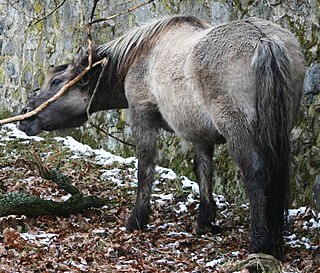
How and when horses became domesticated has been disputed. Although horses appeared in Paleolithic cave art as early as 30,000 BC, these were wild horses and were probably hunted for meat. The clearest evidence of early use of the horse as a means of transport is from chariot burials dated c. 2000 BC. However, an increasing amount of evidence began to support the hypothesis that horses were domesticated in the Eurasian Steppes in approximately 3500 BC. Discoveries in the context of the Botai culture had suggested that Botai settlements in the Akmola Province of Kazakhstan are the location of the earliest domestication of the horse. Warmouth et al. (2012) pointed to horses having been domesticated around 3000 BC in what is now Ukraine and Western Kazakhstan.

A kurgan is a type of tumulus constructed over a grave, often characterized by containing a single human body along with grave vessels, weapons and horses. Originally in use on the Pontic–Caspian steppe, kurgans spread into much of Central Asia and Eastern, Southeast, Western and Northern Europe during the 3rd millennium BC.
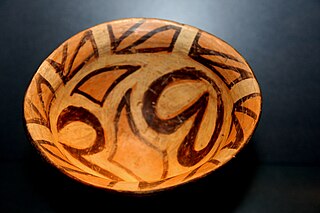
The Cucuteni–Trypillia culture, also known as the Cucuteni culture or the Trypillia culture, is a Neolithic–Chalcolithic archaeological culture of Southeast Europe. It extended from the Carpathian Mountains to the Dniester and Dnieper regions, centered on modern-day Moldova and covering substantial parts of western Ukraine and northeastern Romania, encompassing an area of 350,000 km2 (140,000 sq mi), with a diameter of 500 km.

The Sredny Stog culture is a pre-Kurgan archaeological culture from the 5th–4th millennia BC. It is named after the Dnieper river islet of today's Serednii Stih, Ukraine, where it was first located.
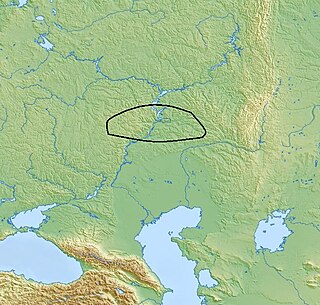
The Khvalynsk culture was a Middle Copper Age Eneolithic culture of the middle Volga region. It takes its name from Khvalynsk in Saratov Oblast. The Khvalynsk culture extended from the Samara Bend in the north to the North Caucasus in the south, from the Sea of Azov in the west to the Ural River in the east. It was preceded by the Early Eneolithic Samara culture.

The Samara culture was an Eneolithic culture that flourished around the turn of the 5th millennium BCE, at the Samara Bend of the Volga River. The Samara culture is regarded as related to contemporaneous or subsequent prehistoric cultures of the Pontic–Caspian steppe, such as the Khvalynsk, Repin and Yamna cultures.

The Dnieper–Donets culture complex (DDCC) was a Mesolithic and later Neolithic culture which flourished north of the Black Sea ca. 5000-4200 BC. It has many parallels with the Samara culture, and was succeeded by the Sredny Stog culture.

The Abashevo culture is a late Middle Bronze Age archaeological culture, ca. 2200–1850 BC, found in the valleys of the middle Volga and Kama River north of the Samara bend and into the southern Ural Mountains. It receives its name from the village of Abashevo in Chuvashia.

Deriivka is an archaeological site located in the village of the same name in Kirovohrad Oblast, Ukraine, on the right bank of the Dnieper. The site dates to ca. 4500—3500 BC and is associated with the Sredny Stog culture.
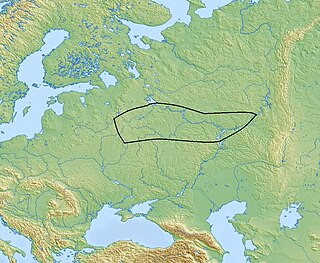
The Fatyanovo–Balanovo culture was a Chalcolithic and early Bronze Age culture within the wider Corded Ware complex which flourished in the forests of Russia from c. 2900 to 2050 BC.

The Middle Dnieper culture is a formative early expression of the Corded Ware culture, ca. 3200—2300 BC, of northern Ukraine and Belarus.

A riding horse or a saddle horse is a horse used by mounted horse riders for recreation or transportation.

The Tiszapolgár culture or Tiszapolgár-Româneşti culture was an Eneolithic archaeological culture of the Great Hungarian Plain, the Banat, Eastern Slovakia, and Ukrainian Zakarpattia Oblast in Central Europe.

The Gaudo Culture is an Eneolithic culture from Southern Italy, primarily in the region of Campania, active at the end of the 4th millennium BC, whose typesite necropolis is located near Paestum, not far from the mouth of the river Sele. Its name comes from the Spina-Gaudo necropolis.

Throughout most of its existence, the Cucuteni-Trypillia culture was fairly stable. Near the end it began to change from a gift economy to an early form of trade called reciprocity, and introduced the apparent use of barter tokens, an early form of money.

The Boian culture, also known as the Giulești–Marița culture or Marița culture, is a Neolithic archaeological culture of Southeast Europe. It is primarily found along the lower course of the Danube in what is now Romania and Bulgaria, and thus may be considered a Danubian culture.

The Prehistory of Transylvania describes what can be learned about the region known as Transylvania through archaeology, anthropology, comparative linguistics and other allied sciences.

The Novodanilovkagroup, also called the Novodanilovka culture, was a Copper Age culture which flourished along the lower Dnieper and the steppes of Ukraine from c. 4400 BC to 3800 BC.
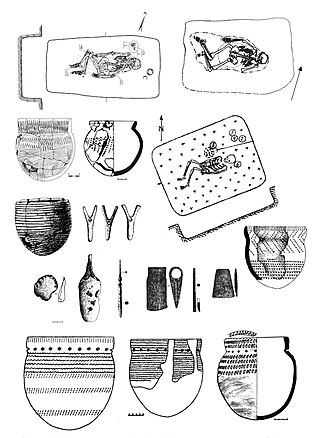
The Repin culture was a 4th millennium BCE Eneolithic archaeological culture located in the Pontic–Caspian steppe and East European forest steppe. It developed from preceding local Neolithic cultures, and later developed into the Yamnaya culture. The economy was based on pastoralism, supplemented by hunting. This culture is sometimes classified as an earlier phase of the Yamnaya culture.
References
- ↑ Макаренко, М. О. (1933). Маріюпільський могильник (in Ukrainian and English). Київ: Всеукраїнська Академія Наук.